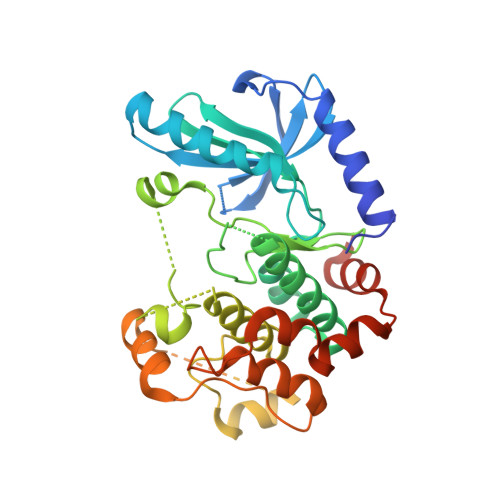Pharmacological Profile of BI 847325, an Orally Bioavailable, ATP-Competitive Inhibitor of MEK and Aurora Kinases.
Sini, P., Gurtler, U., Zahn, S.K., Baumann, C., Rudolph, D., Baumgartinger, R., Strauss, E., Haslinger, C., Tontsch-Grunt, U., Waizenegger, I.C., Solca, F., Bader, G., Zoephel, A., Treu, M., Reiser, U., Garin-Chesa, P., Boehmelt, G., Kraut, N., Quant, J., Adolf, G.R.(2016) Mol Cancer Ther 15: 2388-2398
- PubMed: 27496137
- DOI: https://doi.org/10.1158/1535-7163.MCT-16-0066
- Primary Citation of Related Structures:
5EYK, 5EYM, 5K3Y - PubMed Abstract:
Although the MAPK pathway is frequently deregulated in cancer, inhibitors targeting RAF or MEK have so far shown clinical activity only in BRAF- and NRAS-mutant melanoma. Improvements in efficacy may be possible by combining inhibition of mitogenic signal transduction with inhibition of cell-cycle progression. We have studied the preclinical pharmacology of BI 847325, an ATP-competitive dual inhibitor of MEK and Aurora kinases. Potent inhibition of MEK1/2 and Aurora A/B kinases by BI 847325 was demonstrated in enzymatic and cellular assays. Equipotent effects were observed in BRAF-mutant cells, whereas in KRAS-mutant cells, MEK inhibition required higher concentrations than Aurora kinase inhibition. Daily oral administration of BI 847325 at 10 mg/kg showed efficacy in both BRAF- and KRAS-mutant xenograft models. Biomarker analysis suggested that this effect was primarily due to inhibition of MEK in BRAF-mutant models but of Aurora kinase in KRAS-mutant models. Inhibition of both MEK and Aurora kinase in KRAS-mutant tumors was observed when BI 847325 was administered once weekly at 70 mg/kg. Our studies indicate that BI 847325 is effective in in vitro and in vivo models of cancers with BRAF and KRAS mutation. These preclinical data are discussed in the light of the results of a recently completed clinical phase I trial assessing safety, tolerability, pharmacokinetics, and efficacy of BI 847325 in patients with cancer. Mol Cancer Ther; 15(10); 2388-98. ©2016 AACR.
- Department of Pharmacology and Translational Research, Boehringer Ingelheim RCV GmbH & Co KG, Vienna, Austria. patrizia.sini@boehringer-ingelheim.com.
Organizational Affiliation:


















